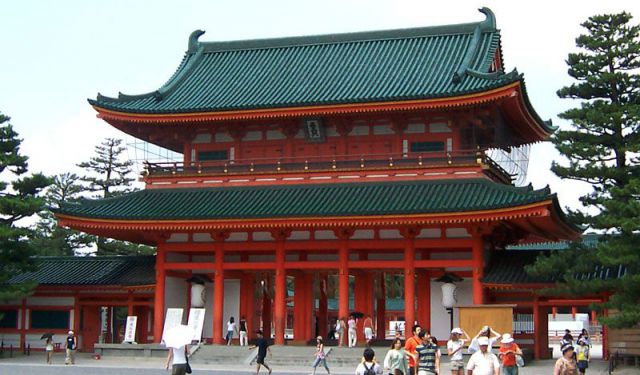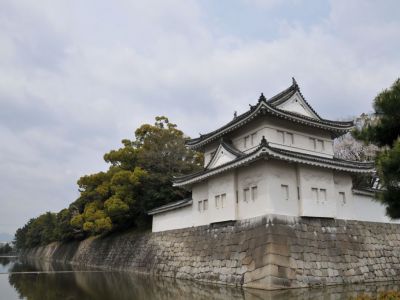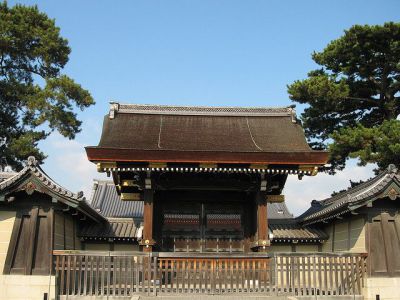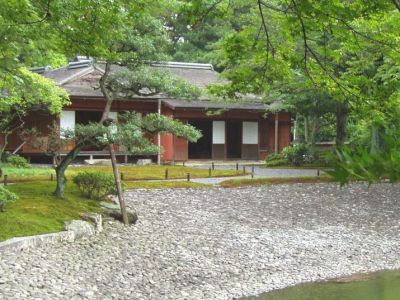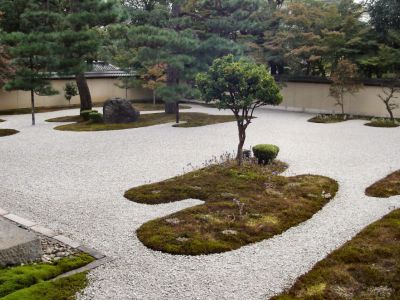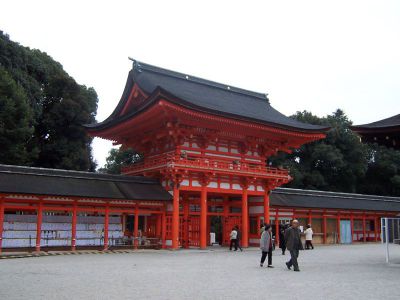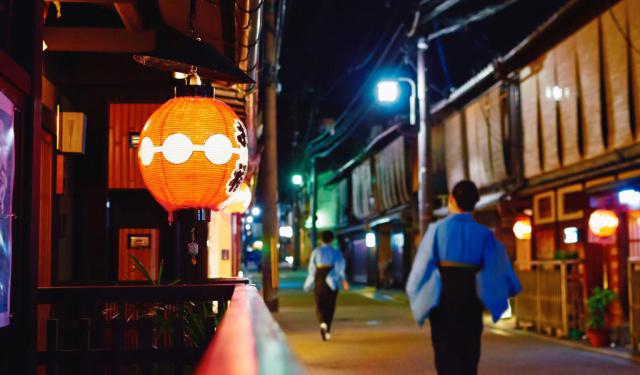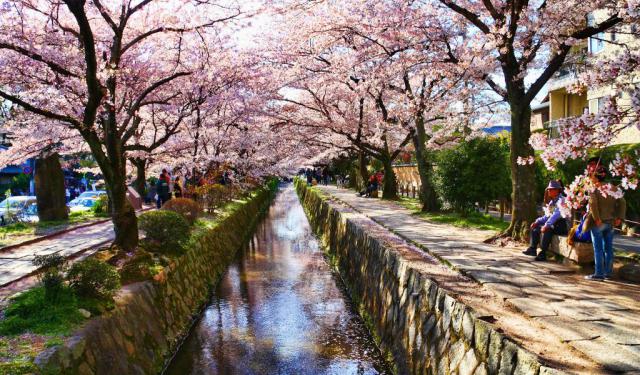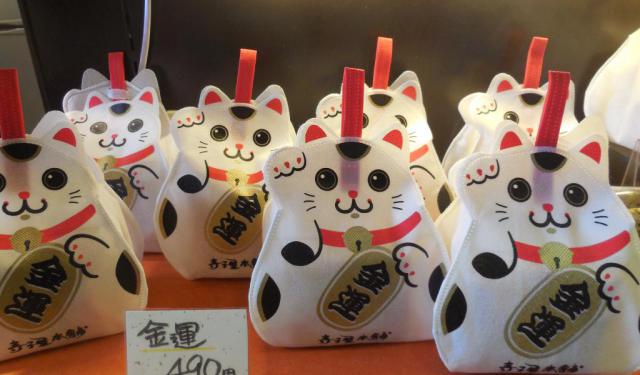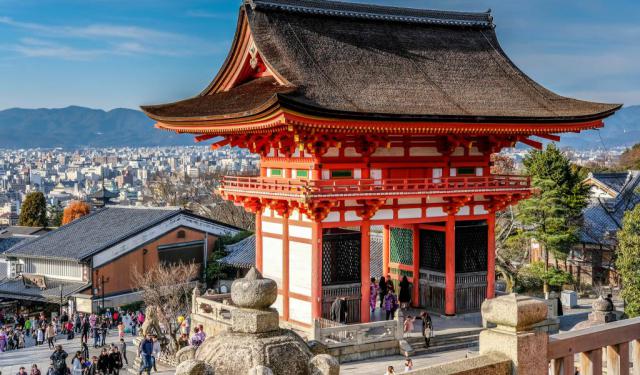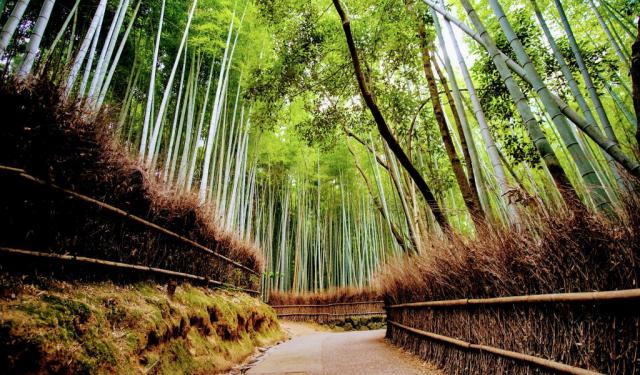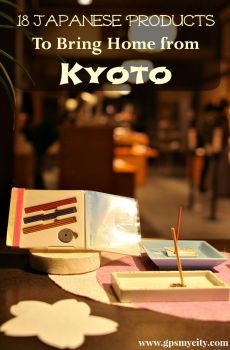Audio Guide: Imperial Kyoto Walking Tour (Self Guided), Kyoto
Kyoto served as Japan’s imperial capital for over 1,000 years, from 794 to 1869, beginning with Emperor Kanmu’s relocation of his court to Heian-kyō (which is Kyoto’s former name). Though political power eventually shifted to the shogunate and later to Tokyo, Kyoto remained the cultural and symbolic heart of Japan. Its long association with the imperial court helped shape it into a refined center of tradition, influencing everything from architecture and religion to literature and garden design. Even today, this historical significance remains visible in the city’s preserved landmarks and serene landscapes.
Among the most iconic sites reflecting Kyoto’s imperial legacy is Nijo Castle, constructed in the early 1600s as a residence for Tokugawa shoguns. Blending military strength with artistic elegance, this castle is known for its “nightingale floors” (squeaking on purpose to fend off stealthy intruders), as well as for intricate painted screens, moats, and fortified stone walls. In essence, it represents a physical manifestation of the balance between imperial grace and shogunate authority. Nearby, the Kyoto Imperial Palace offers visitors a glimpse into the grandeur of classical court life, with its ceremonial halls and expansive gardens that once served as the emperor’s private domain. The palace is a testament to the restrained elegance of Japanese royal architecture.
Next to it lies the Sento Imperial Palace, originally built for retired emperors. Surrounded by tranquil gardens and waterways, it was designed as a peaceful retreat and remains a serene space reflecting imperial taste and tradition. Though visits are limited, it continues to symbolize quiet dignity and introspection.
Also tied to the imperial narrative is Rozan-ji Temple, located east of the palace grounds. Known as the birthplace of the renowned 11th-century novelist, Murasaki Shikibu, the temple is steeped in literary and spiritual heritage. Its moss garden and quiet atmosphere invite reflection. Further north, Shimogamo-Jinja Shrine-a UNESCO World Heritage Site-is one of Kyoto’s oldest sacred spaces, surrounded by a primeval forest. Dedicated to nature deities, it plays a central role in the annual Kamo Festival, preserving ancient Shinto traditions.
Together, these sites form a layered portrait of Kyoto’s imperial past, offering modern visitors a rich and immersive experience. Exploring them provides a rare opportunity to engage with Japan’s dynastic legacy and the artistry that flourished under its imperial rule.
Among the most iconic sites reflecting Kyoto’s imperial legacy is Nijo Castle, constructed in the early 1600s as a residence for Tokugawa shoguns. Blending military strength with artistic elegance, this castle is known for its “nightingale floors” (squeaking on purpose to fend off stealthy intruders), as well as for intricate painted screens, moats, and fortified stone walls. In essence, it represents a physical manifestation of the balance between imperial grace and shogunate authority. Nearby, the Kyoto Imperial Palace offers visitors a glimpse into the grandeur of classical court life, with its ceremonial halls and expansive gardens that once served as the emperor’s private domain. The palace is a testament to the restrained elegance of Japanese royal architecture.
Next to it lies the Sento Imperial Palace, originally built for retired emperors. Surrounded by tranquil gardens and waterways, it was designed as a peaceful retreat and remains a serene space reflecting imperial taste and tradition. Though visits are limited, it continues to symbolize quiet dignity and introspection.
Also tied to the imperial narrative is Rozan-ji Temple, located east of the palace grounds. Known as the birthplace of the renowned 11th-century novelist, Murasaki Shikibu, the temple is steeped in literary and spiritual heritage. Its moss garden and quiet atmosphere invite reflection. Further north, Shimogamo-Jinja Shrine-a UNESCO World Heritage Site-is one of Kyoto’s oldest sacred spaces, surrounded by a primeval forest. Dedicated to nature deities, it plays a central role in the annual Kamo Festival, preserving ancient Shinto traditions.
Together, these sites form a layered portrait of Kyoto’s imperial past, offering modern visitors a rich and immersive experience. Exploring them provides a rare opportunity to engage with Japan’s dynastic legacy and the artistry that flourished under its imperial rule.
How it works: Download the app "GPSmyCity: Walks in 1K+ Cities" from Apple App Store or Google Play Store to your mobile phone or tablet. The app turns your mobile device into a personal tour guide and its built-in GPS navigation functions guide you from one tour stop to next. The app works offline, so no data plan is needed when traveling abroad.
Imperial Kyoto Walking Tour Map
Guide Name: Imperial Kyoto Walking Tour
Guide Location: Japan » Kyoto (See other walking tours in Kyoto)
Guide Type: Self-guided Walking Tour (Sightseeing)
# of Attractions: 5
Tour Duration: 2 Hour(s)
Travel Distance: 4.1 Km or 2.5 Miles
Author: emma
Sight(s) Featured in This Guide:
Guide Location: Japan » Kyoto (See other walking tours in Kyoto)
Guide Type: Self-guided Walking Tour (Sightseeing)
# of Attractions: 5
Tour Duration: 2 Hour(s)
Travel Distance: 4.1 Km or 2.5 Miles
Author: emma
Sight(s) Featured in This Guide:
- Nijo Castle
- Kyoto Imperial Palace
- Sento Imperial Palace
- Rozan-ji Temple
- Shimogamo-Jinja Shrine
1) Nijo Castle (must see)
If you fancy a crash course in shogunate style, check out Nijo Castle-Kyoto’s architectural declaration: "Yes, I rule the realm, but do it tastefully." Its moat and stone walls are tidy and well-kept, though not exactly built for medieval tank warfare. But don't let their modesty fool you-what’s inside is where the real power play unfolds.
Built in 1603, Nijo wasn’t about brute force-it was a strategic base from which Tokugawa shoguns could oversee the emperor. Enter through the dramatic Chinese-style gate and you're headed straight into the Ninomaru Palace, constructed in 1626 to impress the emperor during a ceremonial visit. Think of it as a 17th-century flex, complete with hand-picked artists decorating over 1,000 paintings across five interconnected buildings. These spaces weren’t just eye candy-they laid out a strict social pecking order, from low-level bureaucrats to top-tier Tokugawa allies.
And then there’s the Nightingale Corridor. Not an actual aviary, but a squeaky hallway designed to chirp under your feet-an early form of home security to ward off would-be assassins and uninvited guests. As a bonus, those chirps now add a soundtrack to your stroll past golden screens, pine tree paintings (hint: power symbolism), and centuries of elite scheming.
Just outside, the garden adds its own drama. Craggy rocks shout military strength, while the surrounding cherry trees soften the scene with poetic flair-especially in spring, when they’re lit up like nature’s disco ball. Stroll the loop, sip from a tea house, and suddenly you're deep in a samurai movie without the sword fights.
Quick tips before you dive in: socks are a must, as no shoes are allowed inside. Want the full story? Rent the audio guide or hop on the English tour at 10 AM or 12:30 PM. Trust us, this Nightingale has tales to sing...
Built in 1603, Nijo wasn’t about brute force-it was a strategic base from which Tokugawa shoguns could oversee the emperor. Enter through the dramatic Chinese-style gate and you're headed straight into the Ninomaru Palace, constructed in 1626 to impress the emperor during a ceremonial visit. Think of it as a 17th-century flex, complete with hand-picked artists decorating over 1,000 paintings across five interconnected buildings. These spaces weren’t just eye candy-they laid out a strict social pecking order, from low-level bureaucrats to top-tier Tokugawa allies.
And then there’s the Nightingale Corridor. Not an actual aviary, but a squeaky hallway designed to chirp under your feet-an early form of home security to ward off would-be assassins and uninvited guests. As a bonus, those chirps now add a soundtrack to your stroll past golden screens, pine tree paintings (hint: power symbolism), and centuries of elite scheming.
Just outside, the garden adds its own drama. Craggy rocks shout military strength, while the surrounding cherry trees soften the scene with poetic flair-especially in spring, when they’re lit up like nature’s disco ball. Stroll the loop, sip from a tea house, and suddenly you're deep in a samurai movie without the sword fights.
Quick tips before you dive in: socks are a must, as no shoes are allowed inside. Want the full story? Rent the audio guide or hop on the English tour at 10 AM or 12:30 PM. Trust us, this Nightingale has tales to sing...
2) Kyoto Imperial Palace (must see)
The Kyoto Imperial Palace-once the VIP lounge of Japan’s emperors (back when Kyoto still held the title of capital city)-was established in 794. This place remained home to the Imperial Family up until 1869, when the royals packed up and moved to Tokyo during the Meiji Restoration period (which brought about the modernization and Westernization of the country at the turn of the 20th century). The palace you see today dates from 1855, rebuilt after a series of devastating fires. Luckily, the entire complex retained its timeless look-with elegant wooden buildings, sweeping rooflines, and a firm commitment to traditional flair, complemented by a modern touch.
Set within the spacious Kyoto Gyoen National Garden, the palace grounds once teemed with court nobles and aristocrats. Back in its glory days, this leafy enclave held over 200 noble residences-like an elite gated community, only without the gates... These days, the grounds are open to the public and lined with some 50,000 trees, offering peace, shade, and the occasional squirrel sighting. Despite the modern calm, this place still hosts formal imperial ceremonies, keeping tradition alive with a bow and a fan flutter.
The palace itself, affectionately called Gosho by locals, is refreshingly unfortified-no defensive moats, towers, or any “keep out” signs. Instead, it embraces a philosophy of openness, with wide verandas looking out on reflective ponds, and sliding doors inviting the outdoors in. While you can’t wander inside the buildings, the gravel paths, the manicured, serene courtyards, and the dignified architecture outside are yours to explore and admire, camera in hand.
Curious minds can either follow a self-guided route marked with English signs or take a free one-hour guided tour from the Imperial Household Office-just make sure to bring your passport and a sense of wonder. Tours run daily at 10 AM and 2 PM and cover highlights like the grand Shishinden Hall, ornate gates, and the tree-filled serenity of Kyoto Gyoen Park, replete with shaded walkways, plum groves, and quiet retreats. So, whether you come for the history, the architecture, or just a break from temple fatigue, the Kyoto Imperial Palace delivers timeless elegance, minus the royal curtsies...
Set within the spacious Kyoto Gyoen National Garden, the palace grounds once teemed with court nobles and aristocrats. Back in its glory days, this leafy enclave held over 200 noble residences-like an elite gated community, only without the gates... These days, the grounds are open to the public and lined with some 50,000 trees, offering peace, shade, and the occasional squirrel sighting. Despite the modern calm, this place still hosts formal imperial ceremonies, keeping tradition alive with a bow and a fan flutter.
The palace itself, affectionately called Gosho by locals, is refreshingly unfortified-no defensive moats, towers, or any “keep out” signs. Instead, it embraces a philosophy of openness, with wide verandas looking out on reflective ponds, and sliding doors inviting the outdoors in. While you can’t wander inside the buildings, the gravel paths, the manicured, serene courtyards, and the dignified architecture outside are yours to explore and admire, camera in hand.
Curious minds can either follow a self-guided route marked with English signs or take a free one-hour guided tour from the Imperial Household Office-just make sure to bring your passport and a sense of wonder. Tours run daily at 10 AM and 2 PM and cover highlights like the grand Shishinden Hall, ornate gates, and the tree-filled serenity of Kyoto Gyoen Park, replete with shaded walkways, plum groves, and quiet retreats. So, whether you come for the history, the architecture, or just a break from temple fatigue, the Kyoto Imperial Palace delivers timeless elegance, minus the royal curtsies...
3) Sento Imperial Palace
If you ever wondered what the imperial retirement plan-Kyoto-style-can possibly look like, here's your chance. Check out the Sento Imperial Palace (or Sento Gosho if you're feeling formal), built in 1630 for Emperor Go-Mizunoo when he decided to call it a day. Two centuries later, alas, fire consumed the property. But like any good royal legacy, it didn’t vanish-it evolved. Today, it’s still part of the Imperial family’s Kyoto digs, quietly nestled behind an age-old mud wall that knows more secrets than it lets on.
Inside is a sprawling 22-acre garden that’s less "backyard" and more "living museum of serenity." To get in, you’ll need to join a free tour run by the Imperial Household Agency-because nothing illustrates exclusivity better than a wooden gate and a bureaucratic approval process...
Now, the garden isn’t just green. It’s thoughtfully green. We're talking pebble-edged ponds so pristine they might as well be hand-curated, and tea houses that look like they’ve time-traveled straight out of a minimalist dream. The Seikatei teahouse even lets you peek inside-because, when it comes to appreciating "imperial style," nothing can beat the quiet admiration of architecture through a respectfully ajar door.
The tours are all in Japanese, but don’t worry-audio guides in other languages are also available, so you won’t have to pretend to understand everything while nodding thoughtfully at moss.
And here’s the twist: this noble garden isn’t all solemn strolls and poetry. Among the pines and perfectly groomed paths, you'll find groves of plum and cherry trees, plus the occasional tennis match or baseball practice. Yes, really. Add in some dog walkers, birdwatchers, and people just trying to mentally escape their inboxes, and you’ve got a city oasis with imperial flair-and just enough whimsy to remind you that, like anyone else, retired emperors needed fresh air and a good view.
Inside is a sprawling 22-acre garden that’s less "backyard" and more "living museum of serenity." To get in, you’ll need to join a free tour run by the Imperial Household Agency-because nothing illustrates exclusivity better than a wooden gate and a bureaucratic approval process...
Now, the garden isn’t just green. It’s thoughtfully green. We're talking pebble-edged ponds so pristine they might as well be hand-curated, and tea houses that look like they’ve time-traveled straight out of a minimalist dream. The Seikatei teahouse even lets you peek inside-because, when it comes to appreciating "imperial style," nothing can beat the quiet admiration of architecture through a respectfully ajar door.
The tours are all in Japanese, but don’t worry-audio guides in other languages are also available, so you won’t have to pretend to understand everything while nodding thoughtfully at moss.
And here’s the twist: this noble garden isn’t all solemn strolls and poetry. Among the pines and perfectly groomed paths, you'll find groves of plum and cherry trees, plus the occasional tennis match or baseball practice. Yes, really. Add in some dog walkers, birdwatchers, and people just trying to mentally escape their inboxes, and you’ve got a city oasis with imperial flair-and just enough whimsy to remind you that, like anyone else, retired emperors needed fresh air and a good view.
4) Rozan-ji Temple
To the east of Kyoto’s Imperial Palace stands a temple with serious literary street cred-Rozan-ji, built on the former estate of the father of Murasaki Shikibu, the noblewoman who went down in history as the author of the epic novel, The Tale of Genji, often regarded as the world’s first novel, penned in the 11th century. Devotees of classic literature still drop by to pay their respects to Lady Murasaki, the Heian-era icon who turned palace gossip into timeless prose.
Rozan-ji itself was founded way back in 938 by the Buddhist priest Ganzan Daishi on a hill called Funaokayama. And while much of Kyoto went up in flames in 1571 thanks to warlord Oda Nobunaga’s scorched-earth policy, Rozan-ji somehow dodged the fireball. Later, Emperor Kokaku gave it an upgrade and relocated it to its current, more serene spot.
The temple grounds are now home to the graves of numerous Edo-period VIPs, including Jocho Busshi, the Heian sculptor behind some of Japan’s most revered Buddhist statues. Out front, a moss and gravel garden blooms with delicate bellflowers, the kind of place you might expect Genji himself to stroll through-deep in thought, fan in hand...
Visit in early February, precisely on the 2nd and 3rd day of the month, and you'll catch Rozan-ji’s theatrical side during the Setsubun festivities, featuring a traditional annual court ceremony of driving out demons. Picture this: monks, masks, and ritual demon-banishing that’s part ancient rite, part Kyoto drama. In short, Rozan-ji offers literary heritage, imperial whispers, and just the right amount of spiritual flair.
Rozan-ji itself was founded way back in 938 by the Buddhist priest Ganzan Daishi on a hill called Funaokayama. And while much of Kyoto went up in flames in 1571 thanks to warlord Oda Nobunaga’s scorched-earth policy, Rozan-ji somehow dodged the fireball. Later, Emperor Kokaku gave it an upgrade and relocated it to its current, more serene spot.
The temple grounds are now home to the graves of numerous Edo-period VIPs, including Jocho Busshi, the Heian sculptor behind some of Japan’s most revered Buddhist statues. Out front, a moss and gravel garden blooms with delicate bellflowers, the kind of place you might expect Genji himself to stroll through-deep in thought, fan in hand...
Visit in early February, precisely on the 2nd and 3rd day of the month, and you'll catch Rozan-ji’s theatrical side during the Setsubun festivities, featuring a traditional annual court ceremony of driving out demons. Picture this: monks, masks, and ritual demon-banishing that’s part ancient rite, part Kyoto drama. In short, Rozan-ji offers literary heritage, imperial whispers, and just the right amount of spiritual flair.
5) Shimogamo-Jinja Shrine
Let’s rewind the clock to the 6th century-back when Kyoto wasn’t even Kyoto yet-and meet Shimogamo-Jinja, one of the city’s oldest shrines and now a proud member of the elite club of 17 UNESCO World Heritage sites in Kyoto. That’s right, this isn’t just another pretty torii gate-it’s got serious historical clout.
Originally built to keep evil spirits out and good vibes in, Shimogamo-Jinja sits inside Tadasu no Mori, which translates to “The Forest of Truth.” Think of it as Kyoto’s ancient lie detector, only greener. Here, among towering trees and whispering leaves, you’ll find the shrine dedicated to some serious deity heavyweights: Kamotaketsunumi-no-Mikoto, his daughter Tamayorihime-no-Mikoto, and the ever-dramatic Honoikazuchi-no-Mikoto, the god of fire and thunder. Add in a generous dose of imperial patronage from the Heian era through to the 20th century, and you’ve got yourself one seriously sacred spot.
But if you thought it’s all just solemn rituals and ancient deities, then don't. Shimogamo-Jinja still knows how to throw a party. Every May 15th, it hosts the Aoi Matsuri, or Hollyhock Festival, where Heian-period cosplay meets spiritual parade. And if you swing by in early January, you might catch the Kemari Hajime, a formal New Year’s kickabout of a centuries-old game that looks like soccer, only slower, quieter, and with a lot more silk robes.
As for the forest itself, imagine peaceful bamboo groves, ancient trees, and babbling streams. Honestly, it’s like Kyoto hit pause. And yes, it’s a fantastic alternative to the shoulder-to-shoulder Arashiyama bamboo crowds-here, you’ll actually hear the bamboo rustle instead of a hundred camera shutters.
The shrine is modest, but the atmosphere is anything but. Tadasu no Mori offers shade, serenity, and a chance to wander through living history. Come for the quiet. Stay for the sacred ambiance.
Pro Tip:
Festivals here aren’t your average weekend fairs. If you visit during one, bring along a guide who knows their imperial onions-this way, you’ll get more out of it than just pretty photos and a brochure.
Originally built to keep evil spirits out and good vibes in, Shimogamo-Jinja sits inside Tadasu no Mori, which translates to “The Forest of Truth.” Think of it as Kyoto’s ancient lie detector, only greener. Here, among towering trees and whispering leaves, you’ll find the shrine dedicated to some serious deity heavyweights: Kamotaketsunumi-no-Mikoto, his daughter Tamayorihime-no-Mikoto, and the ever-dramatic Honoikazuchi-no-Mikoto, the god of fire and thunder. Add in a generous dose of imperial patronage from the Heian era through to the 20th century, and you’ve got yourself one seriously sacred spot.
But if you thought it’s all just solemn rituals and ancient deities, then don't. Shimogamo-Jinja still knows how to throw a party. Every May 15th, it hosts the Aoi Matsuri, or Hollyhock Festival, where Heian-period cosplay meets spiritual parade. And if you swing by in early January, you might catch the Kemari Hajime, a formal New Year’s kickabout of a centuries-old game that looks like soccer, only slower, quieter, and with a lot more silk robes.
As for the forest itself, imagine peaceful bamboo groves, ancient trees, and babbling streams. Honestly, it’s like Kyoto hit pause. And yes, it’s a fantastic alternative to the shoulder-to-shoulder Arashiyama bamboo crowds-here, you’ll actually hear the bamboo rustle instead of a hundred camera shutters.
The shrine is modest, but the atmosphere is anything but. Tadasu no Mori offers shade, serenity, and a chance to wander through living history. Come for the quiet. Stay for the sacred ambiance.
Pro Tip:
Festivals here aren’t your average weekend fairs. If you visit during one, bring along a guide who knows their imperial onions-this way, you’ll get more out of it than just pretty photos and a brochure.
Walking Tours in Kyoto, Japan
Create Your Own Walk in Kyoto
Creating your own self-guided walk in Kyoto is easy and fun. Choose the city attractions that you want to see and a walk route map will be created just for you. You can even set your hotel as the start point of the walk.
Gion District Walking Tour
Gion, one of Kyoto’s most captivating districts, is deeply rooted in Japan’s cultural heritage. Located in the Higashiyama (the so-called “Eastern Mountain”) neighborhood, its history dates back to the Sengoku period, when it began as a hospitality area for pilgrims visiting Yasaka Shrine. By the late 18th and early 19th centuries, it had evolved into a renowned entertainment quarter,... view more
Tour Duration: 2 Hour(s)
Travel Distance: 2.8 Km or 1.7 Miles
Tour Duration: 2 Hour(s)
Travel Distance: 2.8 Km or 1.7 Miles
Walk on Philosopher's Path
Looking for a scenic walk with a side of existential pondering in Kyoto, you're inevitably bound to end up on the Philosopher’s Path. Winding its way for about two kilometers along the leafy canal that carries water from Lake Biwa to the foothills, this picturesque walking trail once served as the thinking route of Nishida Kitaro. Back in the first half of the 20th century, the famed... view more
Tour Duration: 2 Hour(s)
Travel Distance: 2.6 Km or 1.6 Miles
Tour Duration: 2 Hour(s)
Travel Distance: 2.6 Km or 1.6 Miles
Kyoto Shopping and Food Tour
The cultural capital of Japan, Kyoto is just as famous as a shopper’s paradise and, without a doubt, the best place in the country to buy traditional and modern Japanese goods. Souvenirs, food, bargains, and various “one-of-a-kind items” are all up for grabs here.
In addition to its shopping scene, Kyoto boasts a rich culinary heritage, from Michelin-starred restaurants to humble street... view more
Tour Duration: 1 Hour(s)
Travel Distance: 2.0 Km or 1.2 Miles
In addition to its shopping scene, Kyoto boasts a rich culinary heritage, from Michelin-starred restaurants to humble street... view more
Tour Duration: 1 Hour(s)
Travel Distance: 2.0 Km or 1.2 Miles
Higashiyama Walking Tour
It'd be fair to say that Kyoto is a theme park for lovers of history, religion, and all things deeply, unmistakably Japanese. If so, Higashiyama Ward, with its long lines, can easily be recognized as its star attraction. Tucked along the city’s eastern edge-hence its poetic name translated as “Eastern Mountain”-this district is where Kyoto flaunts its heritage like a geisha in full... view more
Tour Duration: 1 Hour(s)
Travel Distance: 2.6 Km or 1.6 Miles
Tour Duration: 1 Hour(s)
Travel Distance: 2.6 Km or 1.6 Miles
Arashiyama and Bamboo Grove Walking Tour
The Arashiyama district of Kyoto is slightly out of the way for tourists, but that means you can enjoy it more comfortably.
Undoubtedly, the most popular attraction here is the iconic Bamboo Grove, a mesmerizing forest of towering bamboo stalks that sway gently in the breeze, creating an ethereal atmosphere. This serene setting is a must-visit for travelers seeking tranquility amidst... view more
Tour Duration: 2 Hour(s)
Travel Distance: 3.4 Km or 2.1 Miles
Undoubtedly, the most popular attraction here is the iconic Bamboo Grove, a mesmerizing forest of towering bamboo stalks that sway gently in the breeze, creating an ethereal atmosphere. This serene setting is a must-visit for travelers seeking tranquility amidst... view more
Tour Duration: 2 Hour(s)
Travel Distance: 3.4 Km or 2.1 Miles
Useful Travel Guides for Planning Your Trip
18 Japanese Products To Bring Home from Kyoto
The old capital of Japan, the city of Kyoto has once again been the talk of the world lately, thanks to the bestselling "Memoirs of a Geisha" book and the namesake Hollywood blockbuster movie. Renowned for its impeccable craftsmanship, Japan has so much to amaze a foreign eye with. Many of...
The Most Popular Cities
/ view all
